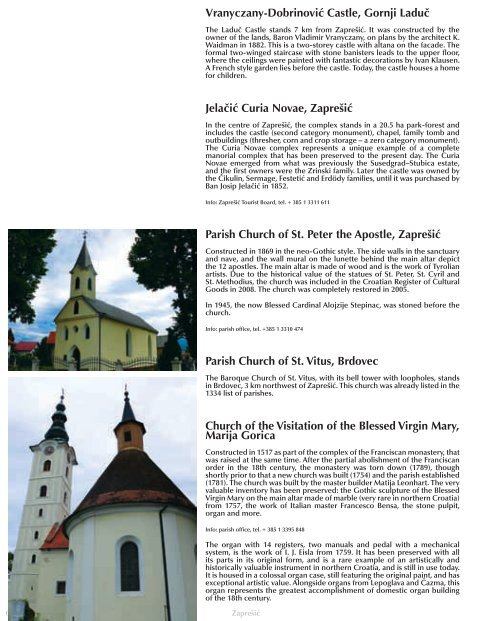The Cultural Heritage of Zagreb County
The Cultural Heritage of Zagreb County
The Cultural Heritage of Zagreb County
Create successful ePaper yourself
Turn your PDF publications into a flip-book with our unique Google optimized e-Paper software.
62 Zaprešić<br />
Vranyczany-Dobrinović Castle, Gornji Laduč<br />
<strong>The</strong> Laduč Castle stands 7 km from Zaprešić. It was constructed by the<br />
owner <strong>of</strong> the lands, Baron Vladimir Vranyczany, on plans by the architect K.<br />
Waidman in 1882. This is a two-storey castle with altana on the facade. <strong>The</strong><br />
formal two-winged staircase with stone banisters leads to the upper floor,<br />
where the ceilings were painted with fantastic decorations by Ivan Klausen.<br />
A French style garden lies before the castle. Today, the castle houses a home<br />
for children.<br />
Jelačić Curia Novae, Zaprešić<br />
In the centre <strong>of</strong> Zaprešić, the complex stands in a 20.5 ha park-forest and<br />
includes the castle (second category monument), chapel, family tomb and<br />
outbuildings (thresher, corn and crop storage – a zero category monument).<br />
<strong>The</strong> Curia Novae complex represents a unique example <strong>of</strong> a complete<br />
manorial complex that has been preserved to the present day. <strong>The</strong> Curia<br />
Novae emerged from what was previously the Susedgrad–Stubica estate,<br />
and the first owners were the Zrinski family. Later the castle was owned by<br />
the Čikulin, Sermage, Festetić and Erdödy families, until it was purchased by<br />
Ban Josip Jelačić in 1852.<br />
Info: Zaprešić Tourist Board, tel. + 385 1 3311 611<br />
Parish Church <strong>of</strong> St. Peter the Apostle, Zaprešić<br />
Constructed in 1869 in the neo-Gothic style. <strong>The</strong> side walls in the sanctuary<br />
and nave, and the wall mural on the lunette behind the main altar depict<br />
the 12 apostles. <strong>The</strong> main altar is made <strong>of</strong> wood and is the work <strong>of</strong> Tyrolian<br />
artists. Due to the historical value <strong>of</strong> the statues <strong>of</strong> St. Peter, St. Cyril and<br />
St. Methodius, the church was included in the Croatian Register <strong>of</strong> <strong>Cultural</strong><br />
Goods in 2008. <strong>The</strong> church was completely restored in 2005.<br />
In 1945, the now Blessed Cardinal Alojzije Stepinac, was stoned before the<br />
church.<br />
Info: parish <strong>of</strong>fice, tel. +385 1 3310 474<br />
Parish Church <strong>of</strong> St. Vitus, Brdovec<br />
<strong>The</strong> Baroque Church <strong>of</strong> St. Vitus, with its bell tower with loopholes, stands<br />
in Brdovec, 3 km northwest <strong>of</strong> Zaprešić. This church was already listed in the<br />
1334 list <strong>of</strong> parishes.<br />
Church <strong>of</strong> the Visitation <strong>of</strong> the Blessed Virgin Mary,<br />
Marija Gorica<br />
Constructed in 1517 as part <strong>of</strong> the complex <strong>of</strong> the Franciscan monastery, that<br />
was raised at the same time. After the partial abolishment <strong>of</strong> the Franciscan<br />
order in the 18th century, the monastery was torn down (1789), though<br />
shortly prior to that a new church was built (1754) and the parish established<br />
(1781). <strong>The</strong> church was built by the master builder Matija Leonhart. <strong>The</strong> very<br />
valuable inventory has been preserved: the Gothic sculpture <strong>of</strong> the Blessed<br />
Virgin Mary on the main altar made <strong>of</strong> marble (very rare in northern Croatia)<br />
from 1757, the work <strong>of</strong> Italian master Francesco Bensa, the stone pulpit,<br />
organ and more.<br />
Info: parish <strong>of</strong>fice, tel. + 385 1 3395 848<br />
<strong>The</strong> organ with 14 registers, two manuals and pedal with a mechanical<br />
system, is the work <strong>of</strong> I. J. Eisla from 1759. It has been preserved with all<br />
its parts in its original form, and is a rare example <strong>of</strong> an artistically and<br />
historically valuable instrument in northern Croatia, and is still in use today.<br />
It is housed in a colossal organ case, still featuring the original paint, and has<br />
exceptional artistic value. Alongside organs from Lepoglava and Čazma, this<br />
organ represents the greatest accomplishment <strong>of</strong> domestic organ building<br />
<strong>of</strong> the 18th century.



